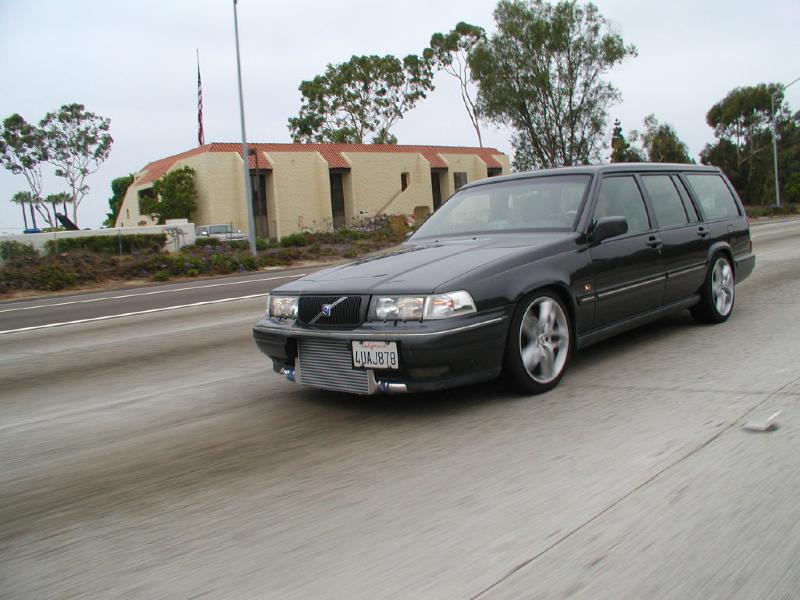-
Hello Guest, welcome to the initial stages of our new platform!
You can find some additional information about where we are in the process of migrating the board and setting up our new software hereThank you for being a part of our community!
You are using an out of date browser. It may not display this or other websites correctly.
You should upgrade or use an alternative browser.
You should upgrade or use an alternative browser.
Intercooler better suited to Automatic or Manual
- Thread starter Beauespirit
- Start date
This guy did maths: http://evo123.net/forum/technical/evo-technical/5755-big-intercooler-lag-myth-dispelled
Basically, the internal volume of an intercooler is small. The volume of air a turbo blows out is large. The lag is minimal.
That said, in general terms an automatic turbo car will be quicker than a manual turbo car, at least until you've gotten flat shifting/launch control working and a very talented pair of feet and a very quick shifting transmission - which will help minimize the lost time during the shifting.
Basically, the internal volume of an intercooler is small. The volume of air a turbo blows out is large. The lag is minimal.
That said, in general terms an automatic turbo car will be quicker than a manual turbo car, at least until you've gotten flat shifting/launch control working and a very talented pair of feet and a very quick shifting transmission - which will help minimize the lost time during the shifting.
Lord_Athlon
300+ Clurb
- Joined
- May 20, 2003
- Location
- Eau Claire, WI.
Volvo did increase boost because the intercooler allowed less detonation. What you guys don't know is that I own 5 of these 240 Turbos and all of them didn't come with intercooler. I was trying to decided if I should put the intercooler, that I picked up in the junk yard, with the Turbo that has the Automatic or the Manual. Of course the stock intercooler doesn't even come close with what the aftermarket offers, but I like to keep some of my rides as stock as possible.


S
smokeyfan1000
Guest
Aftercooler yes, intercooler yes, no intercooler BAD!!!
LOL you left out "outercooler" yes
Mueller
Active member
- Joined
- Oct 12, 2004
- Location
- Antioch, CA
Volvo did increase boost because the intercooler allowed less detonation. What you guys don't know is that I own 5 of these 240 Turbos and all of them didn't come with intercooler. I was trying to decided if I should put the intercooler, that I picked up in the junk yard, with the Turbo that has the Automatic or the Manual. Of course the stock intercooler doesn't even come close with what the aftermarket offers, but I like to keep some of my rides as stock as possible.
Grab another 240 intercooler from the wreckers and do both an auto and a manual? People throw those thing away (or darn near free)
If you like to keep your cars as stock as possible I'd venture to say that you don't beat the hell out of them as well, so is a 1/2 second or whatever difference it could make really going to matter or not?
It is not like the addition of an intercooler is not 100% reversible or that you cannot experiment and swap it out if you don't like it.
S
smokeyfan1000
Guest
the Volvo R Sport intercooler kit, also came with an autotrans modification....valve body or something?
Mueller
Active member
- Joined
- Oct 12, 2004
- Location
- Antioch, CA
Or one could run E85 and not worry about the intercooler as much!
VB242
I.M. Weasel
- Joined
- Sep 21, 2011
- Location
- Driving the No Malarkey Bus
LOL you left out "outercooler" yes
There is some speculation on this site that it's called an aftercooler not an intercooler, even though Volvo made some badges that said "Intercooler" I believe. Intercooler makes sense to me since it's between the turbo and the manifold, but these other wags say this only applies to compound turbos where the air is cooled between turbo stages. My company uses aftercoolers integral to large air drying systems, they cool the air discharged from an air compressor before it gets passed through a salt pellet tank that reduce the air's dewpoint down 40F, mainly used with large sandblasting setups.
Last edited:
Yeah technically they are aftercoolers.
See that's where we get into a little grey area. In the power generation world, intercoolers are used between turbines. In the automotive world, intercoolers are used between the compressor and an internal combustion engine, or between a compressor and a turbine in a sequential setup. In the HD diesel world, they call them all aftercoolers.
745 TurboGreasel
New member
- Joined
- May 10, 2005
- Location
- Freedom CA
Consider a bumpercooler if you use paddle shifters.


From wikipedia:
"The inter prefix in the device name originates from historic compressor designs. In the past, aircraft engines were built with charge air coolers that were installed between multiple stages of forced induction,[citation needed] thus the designation of inter. Modern automobile designs are technically designated aftercoolers because of their placement at the end of the supercharging chain. This term is now considered archaic in modern automobile terminology, since most forced-induction vehicles have single-stage superchargers or turbochargers, although "aftercooler" is still in common use in the piston-engined aircraft industry. In a vehicle fitted with two-stage turbocharging, it is possible to have both an intercooler (between the two turbocharger units) and an aftercooler (between the second-stage turbo and the engine). The JCB Dieselmax land speed record-holding car is an example of such a system. In general, an intercooler or aftercooler is said to be a charge-air cooler."
http://en.wikipedia.org/wiki/Intercooler
Not that it matters. You say "Intercooler" and we all know what you mean. I just like trivia.
"The inter prefix in the device name originates from historic compressor designs. In the past, aircraft engines were built with charge air coolers that were installed between multiple stages of forced induction,[citation needed] thus the designation of inter. Modern automobile designs are technically designated aftercoolers because of their placement at the end of the supercharging chain. This term is now considered archaic in modern automobile terminology, since most forced-induction vehicles have single-stage superchargers or turbochargers, although "aftercooler" is still in common use in the piston-engined aircraft industry. In a vehicle fitted with two-stage turbocharging, it is possible to have both an intercooler (between the two turbocharger units) and an aftercooler (between the second-stage turbo and the engine). The JCB Dieselmax land speed record-holding car is an example of such a system. In general, an intercooler or aftercooler is said to be a charge-air cooler."
http://en.wikipedia.org/wiki/Intercooler
Not that it matters. You say "Intercooler" and we all know what you mean. I just like trivia.
OttoB
Well-known member
- Joined
- Aug 2, 2006
Hintercooler? Zwischencooler?
John V outside agitator
Active member
- Joined
- Mar 25, 2005
- Location
- Sleezattle, WA, USA
Volvo made 'stock" cars... you'll never be able to do what they did, only a simulacrum of that. So why bother?
Junk the autotragic trans* and put in good gearboxes, that solves several problems at once.
The turn OP DA BOOOST.
*Unless maybe you're a hairdresser of a Texan...You know what they say about Texans dontcha?
Junk the autotragic trans* and put in good gearboxes, that solves several problems at once.
The turn OP DA BOOOST.
*Unless maybe you're a hairdresser of a Texan...You know what they say about Texans dontcha?
noz-e8tr
Well-known member
- Joined
- Aug 27, 2003
- Location
- Ocean Springs, MS
You know what they say about Texans dontcha?
Whats that John? They make good paying customers? lolo

2manyturbos
Moderator
- Joined
- Mar 8, 2003
- Location
- Monroe, OR USA
I read somewhere that the non-intercooled cars was quicker in getting boost because the air didn't have to travel as far as with the stock intercooler setup. Supposedly it's noticeable, if that's the case it will take longer to get the power back on when shifting. I definately noticed it with the old 930 Turbos.
You remember correctly. That's why serious builders go for something with a lot less volume/greater heat exchange properties. Water to air intercoolers, small air to air intercoolers cooled by compressed gas charges etc. The cheap/easy version is the large air-air intercooler that we see on everything out in the real world. Some of the really quick turbo drag cars that are running alcohol do not furn ICs since the alcohol itself pulls so much heat out of the air charge. Ford has been experimenting with AC refrigerant cooled intercooling systems. That way you can run short bursts with a much smaller intercooler that can pull more heat in a given time for a short time interval. It doesn't pan out for long term charge cooling. It's those damn laws of physics that screw everything up. Nothing's free in the world of physics.
volvinator
Member
- Joined
- Jan 11, 2007
- Location
- Tucson Az
Your thinking to hard. Just put it on and be done with it.
2manyturbos
Moderator
- Joined
- Mar 8, 2003
- Location
- Monroe, OR USA
Your thinking to hard. Just put it on and be done with it.
Just letting him know he's right, instead, of filling his brain with tribal BS. The best solution for 99% of us in the REAL world is a properly sized air-air intercooler/aftercooler.
